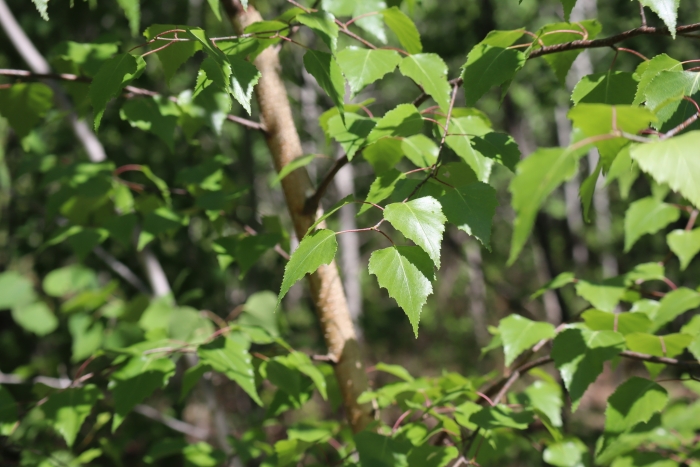Gray Birch
(Betula populifolia)
Gray Birch (Betula populifolia)
/
/

© Henry "Nick" Robertson
CC BY-SA 4.0
Image By:
© Henry "Nick" Robertson
Recorded By:
Copyright:
CC BY-SA 4.0
Copyright Notice:
Photo by: © Henry "Nick" Robertson | License Type: CC BY-SA 4.0 | License URL: http://creativecommons.org/licenses/by-sa/4.0/ | Uploader: henrythesick | Publisher: iNaturalist |


















































Estimated Native Range
Summary
Betula populifolia, commonly known as Gray Birch, is a deciduous tree native to open woodlands, forest edges, and especially early successional fields in the northeastern United States and southeastern Canada. It is a pioneer species, often one of the first to colonize disturbed sites, and typically reaches 20 to 30 feet in height with a slender, often multi-trunked form. The bark is distinctive, being smooth, grayish-white with characteristic black triangular patches at the base of its branches, and unlike the paper birch, it does not exfoliate. The leaves are triangular and the flowers are wind-pollinated catkins, with the male catkins being more prominent and showy in the spring.
Gray Birch is valued for its ability to quickly cover bare ground, providing erosion control and habitat for wildlife. It is often used in reclamation projects and as an ornamental tree in residential landscapes. This birch prefers full sun to partial shade and is adaptable to a variety of soil conditions, though it thrives in well-drained, acidic soils. It is relatively low-maintenance but can be susceptible to the bronze birch borer and birch leafminer. Due to its shallow root system, it is not recommended for planting near sidewalks or foundations where roots may cause damage.CC BY-SA 4.0
Gray Birch is valued for its ability to quickly cover bare ground, providing erosion control and habitat for wildlife. It is often used in reclamation projects and as an ornamental tree in residential landscapes. This birch prefers full sun to partial shade and is adaptable to a variety of soil conditions, though it thrives in well-drained, acidic soils. It is relatively low-maintenance but can be susceptible to the bronze birch borer and birch leafminer. Due to its shallow root system, it is not recommended for planting near sidewalks or foundations where roots may cause damage.CC BY-SA 4.0
Plant Description
- Plant Type: Tree
- Height: 20-40 feet
- Width: 10-20 feet
- Growth Rate: Rapid, Moderate
- Flower Color: N/A
- Flowering Season: Spring
- Leaf Retention: Deciduous
Growth Requirements
- Sun: Full Sun, Part Shade
- Water: Low, Medium
- Drainage: Fast, Medium, Slow
Common Uses
Bank Stabilization, Bird Garden, Border Plant, Deer Resistant, Erosion Control, Low Maintenance, Salt Tolerant, Water Garden
Natural Habitat
Open woodlands, forest edges, and especially early successional fields
Other Names
Common Names: Fire Birch , White Birch , Wire Birch , Grey Birch , Poplar Birch
Scientific Names: Betula populifolia , Betula acuminata , Betula alba subsp. populifolia , Betula alba var. populifolia , Betula cuspidata , Betula cuspidata , Betula excelsa var. canadensis , Betula lenta var. populifolia , Betula populifolia f. incisifolia , Betula populifolia f. laciniata
GBIF Accepted Name: